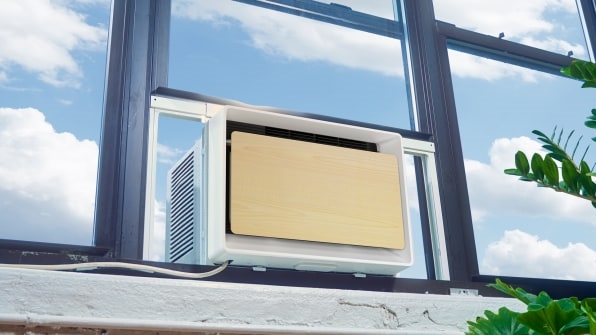This easy-install, design-forward AC has gotten me through the summer’s heat waves
The first time I installed an air conditioning unit—heaving and wedging it with no small effort onto the sill of a fourth-floor bedroom window—I was shocked that more units don’t fall out and plummet to the ground.
Even though the stakes at my current, first-floor apartment are lower, every summer I challenge myself to see how long I can stand a sweltering bedroom or home office before caving and attempting my annual dance with an unwieldy, 70-pound rectangle with accordion wings that manages to stay in place via pressure and three little screws. And every year I think, like the protagonist of a TV infomercial, that there has to be a better way.

Enter July. Founded in 2020 by Muhammad Saigol and Erik Rauterkus, the company got off to a buzzy start, with its design-minded, easy-install window unit racking up a 20,000-person wait list. In all its marketing, July claims to have a superior installation approach and an aesthetically pleasing, minimalist aesthetic. So, when the company reached out to see if I’d like to test it, I was intrigued (and also sweating because it was mid-June, and I hadn’t yet installed an AC in my home office).
After some shipping delays, the July Small air conditioner was sitting in my entryway in a box that, despite being well-designed with plastic-reinforced handles for easy carrying, felt absurdly large for a 6,000-BTU AC. Once it was finally open (lots of empty space in that box), I saw that there weren’t that many steps for installation. Rather than the standard window AC rigmarole of screwing the plastic wings onto the unit itself, July provides a frame that fits into the window before the air conditioner itself enters the mix. It also replaces the accordion wings with retractable screens that hook in place to fill the space between the unit and the edge of the frame.
With the frame in place, it was just a matter of lifting the unit itself into the frame until it gave a satisfying click. It was still heavy, but I didn’t have to engage in an awkward balancing act while trying to secure the wings and lower the window at the same time. Once the July AC is installed, you’re meant to put a stylish, pick-a-color-and-fabric front cover onto the unit, but mine didn’t initially come with one (a delivery error remedied the next day). When I turned the July on, I immediately noticed the impressive power that it had for a unit its size.

Even without a front cover, the July unit cuts an attractive silhouette. And with a front cover (they come in various colors and finishes; mine is green plastic), it looks like something that wouldn’t be out of place on the set of one of the many Star Wars series, with sleek grates well hidden in the unit’s recesses. The unit also comes with a chunky, sky-blue remote and has an app that can be paired with your machine. The app comes handy, allowing you to pre-cool a room a few minutes before you enter or turn off the unit from another room.
Beyond the standard cooling function, the July also has a simple fan function, a dehumidifier mode, and an eco mode that turns off the unit when the room reaches the desired temperature. My July effectively cools my entire 80-square-foot room quickly, and the eco mode does a good job of turning back on right when it was needed. It’s also relatively quiet for an air conditioner. I sit very close to mine and haven’t had any complaints during Zoom meetings or Slack huddles.
Some might see the July’s price tage—the 6,000-BTU unit is $399 and the 8,000-BTU unit is $449—as a sticking point. I’ll note that the smaller unit is one of the most effective air conditioners of that size I’ve ever tried. The company also purports to be eco-conscious, offsetting emissions from every unit sold via a partnership with CarbonFund. In addition, the larger unit uses a refrigerant that July says emits one-third the CO2 as traditional refrigerants. Ultimately, it’s a question of how frustrated you want to be at your window unit. If you’re anything like me and ready to be done with the annual AC wrestle fest, the July a deal worth considering.
(26)


